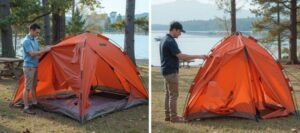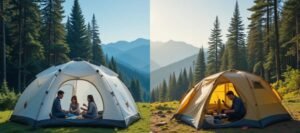1. What are the main advantages of an ultralight tent compared to a traditional tent for long-distance backpackers?
- Answer: Ultralight tents reduce weight and strain during long treks, are compact for easy packing, and offer quick setup. However, they might compromise on durability and interior space compared to traditional tents.
2. How can you identify early signs of mold or mildew in a stored tent, and which products are most effective for prevention?
- Answer: Early signs include a musty smell, discoloration, or small spots. Preventive measures include using silica gel packs or mold inhibitors and airing out the tent regularly.
3. Between a pop-up tent and an inflatable one, which performs better in strong wind conditions?
- Answer: Inflatable tents are generally better in strong winds due to their flexible frames, which absorb wind forces more effectively. Pop-up tents, while quick to set up, may require additional stability measures.
4. What essential accessories can transform a basic tent into a comfortable winter camping space?
- Answer: Insulated sleeping pads, portable heaters, thermal blankets, snow skirts, and a ventilation system are key to creating a cozy winter camping environment.
5. How do you choose the right tent size for a family of four wanting extra space for gear?
- Answer: A 6-person tent is ideal for a family of four, offering ample space for sleeping and storing gear. Look for models with dividers and vestibules for better organization.
6. Which technological features in smart tents truly enhance comfort during extended camping trips?
- Answer: Built-in solar panels, automatic setup mechanisms, USB charging ports, and climate control systems improve convenience and comfort for longer trips.
7. How can you repair a damaged tent fabric in the field without compromising its waterproofing?
- Answer: Use a repair kit with adhesive patches, clean and dry the damaged area, apply the patch, and seal the edges with a waterproof sealant for added durability.
8. What types of eco-friendly tents available on the market use sustainable materials without sacrificing durability and performance?
- Answer: Eco-friendly tents often use recycled polyester or organic cotton treated with natural waterproofing agents. Brands like Big Agnes and Naturehike provide high-performing, sustainable options.
9. What is the most efficient way to set up a tent on rocky or uneven ground to ensure stability and comfort?
- Answer: Clear debris, use a ground tarp, position the tent on the flattest section, secure it with guylines, and use rock anchors if stakes cannot be driven into the ground.
10. What factors should you consider when buying a tent for camping with pets, especially in wild areas?
- Answer: Look for durable, claw-resistant materials, adequate ventilation, ample floor space, and secure zippers to prevent escapes. A vestibule for pet sleeping is also ideal.
11. What are the best tents for camping in heavy rain?
- Answer: Tents with high waterproof ratings (2000mm+ for the rainfly) like the MSR Hubba Hubba NX or Big Agnes Copper Spur HV UL2 are excellent. Features like fully taped seams and a bathtub floor are essential.
12. How to choose the right tent for family camping?
- Answer: Opt for a spacious tent with multiple rooms, strong weatherproofing, easy setup, and good ventilation. Examples include the Coleman Instant Cabin or similar family-friendly models.
13. What is the best way to waterproof a tent?
- Answer: Clean the tent, apply seam sealant to the interior seams, spray a waterproofing solution like Nikwax on the rainfly, and reapply annually or after heavy use.
14. What are the top-rated tents for cold weather camping?
- Answer: The North Face Mountain 25, Hilleberg Nammatj 2, and MSR Access 2 are top choices, offering strong insulation, durable materials, and protection against extreme weather.
15. How to set up a tent step by step for beginners?
- Answer:
- Choose a flat, dry site.
- Lay down a ground tarp.
- Assemble the poles.
- Attach the tent body to the poles.
- Stake the corners.
- Add the rainfly.
- Tighten with guylines.
16. What is the difference between a 3-season and a 4-season tent?
- Answer: 3-season tents are lightweight and ventilated for mild weather, while 4-season tents are heavier, durable, and designed to withstand snow and high winds.
17. What is the best tent material: canvas, nylon, or polyester?
- Answer: Canvas is durable but heavy, nylon is lightweight but less UV-resistant, and polyester offers a balance of durability, UV resistance, and weather performance, making it the best all-around choice.
18. How to fix a broken tent pole while camping?
- Answer: Use a repair sleeve or splint the pole with a tent stake or stick, securing it with duct tape. For snapped cords, thread a replacement and knot it securely.
19. What are the most lightweight tents for backpacking in 2025?
- Answer: The Zpacks Duplex, Big Agnes Fly Creek HV UL2, and Nemo Hornet Elite are leading choices, offering ultralight designs ideal for long-distance backpackers.
20. How to clean and store a tent properly after camping?
- Answer: Shake out debris, wash with mild soap, air dry completely, and store in a breathable bag. Avoid compressing the tent for extended periods to prevent fabric degradation.
Reviewed and updated on 01/24/2025




